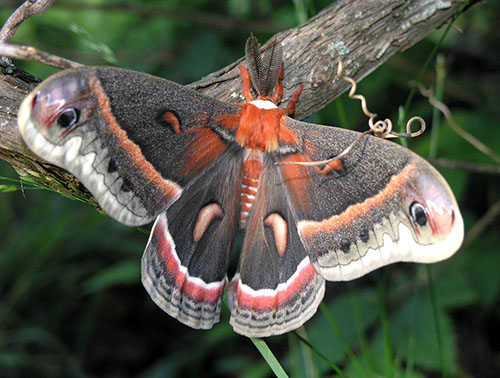While moths are often thought of as being drab and boring, they actually come in a wide range of colors and sizes. Some moths have pink and yellow stripes, others are snow white with black spots, others are pale green, others are yellow with giant orange eye spots, others are brown and red, and the list goes on and on. In North America alone, there are over 10,000 different species of moths, compared to only approximately 700 species of butterflies.

Moths can be active pretty much anytime the nighttime temperatures are above 50 degrees, however, summertime is when you’ll find the largest number and diversity of moths. Attracting and observing moths, or “mothing,” can be a great way to beat the summertime heat while still getting outdoors and learning about a group of organisms that are often overlooked.
There are two general methods for attracting moths to an area where you can observe them. The first is by using lights and the second is by using bait. Each method will often attract different types of moths so it can be advantageous to do both if you want to attract the greatest diversity of moths.
Using Lights
The simplest method of attracting moths is to just turn on your porch light. That will attract some moths, but usually not very many and usually not a very diverse group of moths. You’ll get better results if you put a little more effort into it.
Take a white sheet and drape it over a clothes line or over a rope strung between two trees or some sort of similar setup. Now shine a light on the sheet so that the light illuminates the sheet. Moths will be attracted to the light and will land on the sheet where they will be relatively easy to see and observe. In addition to the moths, it’s also common for lots of other interesting types of insects to be attracted to your light setup.
For best results, setup on a night when the moon isn’t very bright and in as dark of a location as possible. That way your lights are the brightest lights in the area and aren’t competing with the moon, a street lamp, or anything like that. It might take a bit for the moths to come in, so it’s ok to set everything up, go do something else, and then come back periodically to see who has shown up. Just make sure your light system is setup in such a way that it can’t get knocked over and pose a fire or other safety hazard.

When it comes to what type of light to use, you can use a regular light bulb, a black light, or a mercury vapor light. Different types of lights sometimes attract different types of moths, so if you have access to a variety of light types, then try them all and see which ones work best for your area. (Mercury vapor lights get the hottest and therefore are likely to pose the greatest fire risk, so take extra care if you are using them.)
Using Bait
Bait can be used to attract many species of moths in a technique often called “sugaring.” There are many different variations of bait and you can find many recipes on the internet, but the most common ingredients are way-overripe bananas, brown sugar, molasses, and a little beer. Mix everything up so that it is thin enough to spread, but thick enough that it won’t run off. Letting the concoction ferment for a few days before using it can make the bait even more attractive, but isn’t necessary. Spread the mixture on the trunk of a tree at around eye level. Make the patch fairly large – approximately one square foot is generally the recommended size, but don’t worry the moths won’t be checking your dimensions to make sure they are exactly perfect. Come back every half hour to an hour to see who has come to feast at your sugary sweet buffet.
Happy mothing! And feel free to let me know how your mothing adventures go.

This article was part of Shannon’s original Kentucky Pollinators and Backyard Wildlife blog which evolved into the blog for Backyard Ecology.

Backyard Ecology: Exploring Nature in Your Backyard
Nature isn’t just “out there.” It’s all around us, including right outside our doors. Hi, my name is Shannon Trimboli, and I am the host of Backyard Ecology. I live in southcentral Kentucky and am a wildlife biologist, educator, author, beekeeper, and owner of a nursery specializing in plants for pollinators and wildlife conservation. I invite you to join me as we ignite our curiosity and natural wonder, explore our yards and communities, and improve our local pollinator and wildlife habitat. Learn more or subscribe to my email list at www.backyardecology.net.

Leave a Reply